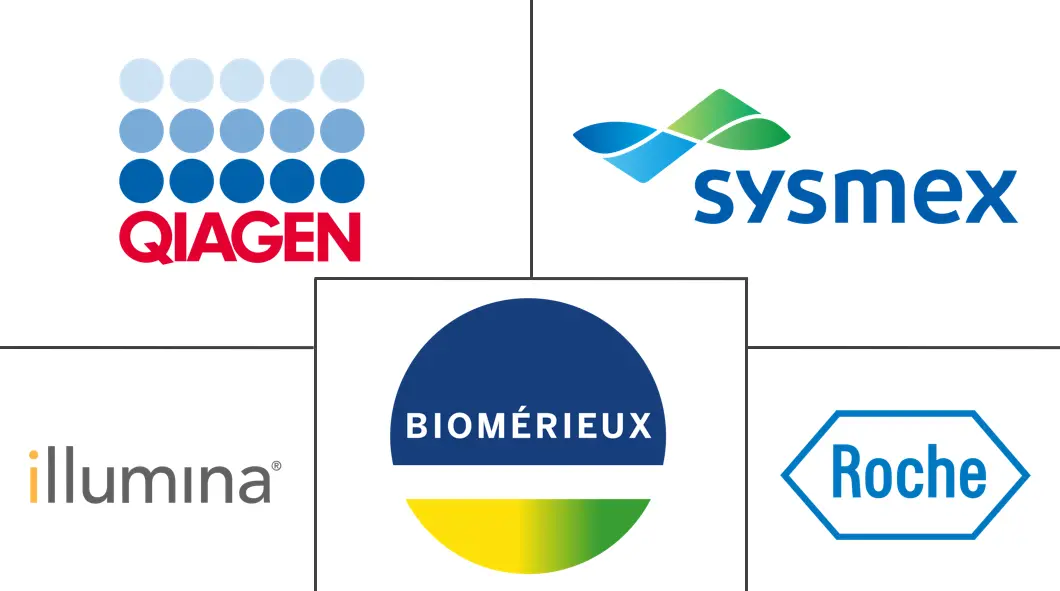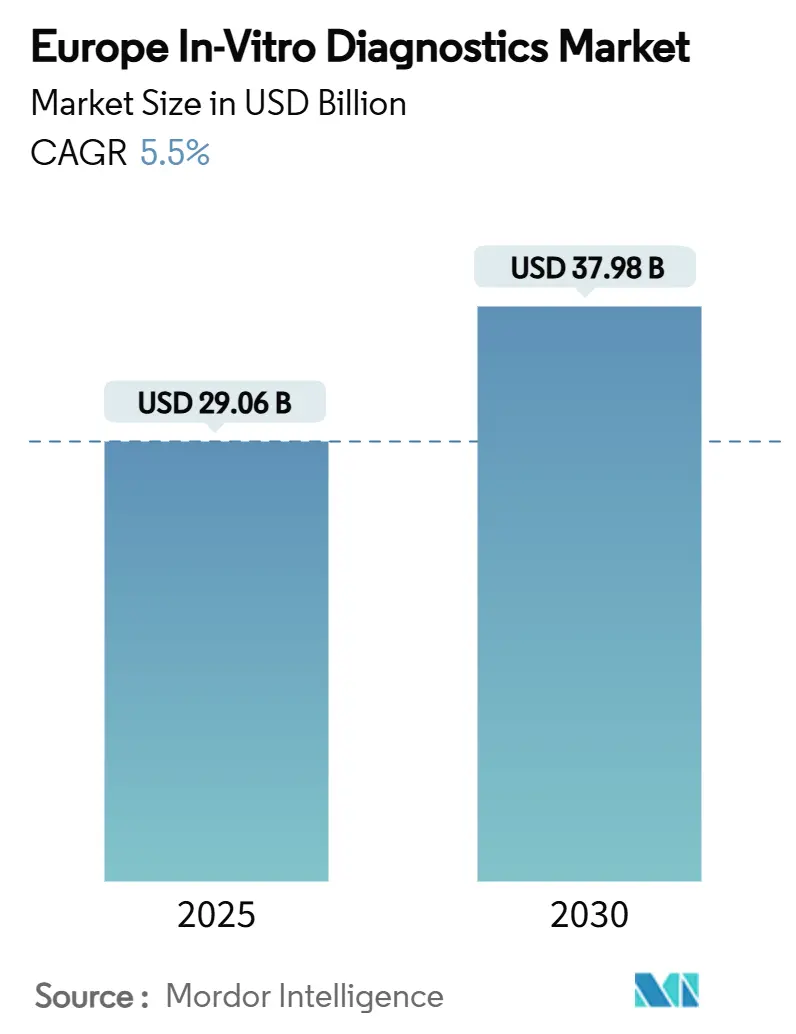
Europe In-Vitro Diagnostics Market Analysis by Mordor Intelligence
The Europe in vitro diagnostics market stands at USD 29.06 billion in 2025 and is forecast to reach USD 37.98 billion by 2030, reflecting a 5.5% CAGR over the period. This trajectory highlights the region’s rapid uptake of advanced testing platforms, the push for early chronic-disease detection and the regulatory lift provided by the EU IVDR. Germany’s leading healthcare infrastructure, the United Kingdom’s digital transformation agenda and the strong shift toward point-of-care models are giving suppliers clear expansion avenues. Molecular techniques are moving from specialised centres into mainstream care pathways, while immunodiagnostics remain a workhorse for routine analysis and screening. Consumables continue to anchor recurring revenue, and non-invasive specimen types are broadening patient access.
Key Report Takeaways
- By test type, immunodiagnostics captured 27% revenue share in 2024; molecular diagnostics is forecast to expand at a 7.2% CAGR through 2030.
- By product and services, reagents and consumables accounted for 65% of Europe in vitro diagnostics market size in 2024 and deliver enduring margins for established players.
- By usability, disposable IVD devices captured 58% share in 2024, and will expand at a 6.9% CAGR.
- By specimen, saliva testing is advancing at a 9.1% CAGR and is eroding the historical dominance of blood and serum samples.
- By end user, home and self-testing solutions are projected to grow at 7.5% CAGR between 2025-2030, challenging the 43% share held by hospitals and clinics in 2024.
- By application, Infectious Diseases captured 33% share in 2024, while oncology will expand at a 6.8% CAGR.
- By country, Germany held 31% of Europe in vitro diagnostics market share in 2024, whereas the United Kingdom is projected to post the fastest 6.5% CAGR to 2030.
Europe In-Vitro Diagnostics Market Trends and Insights
Drivers Impact Analysis
| Driver | (~) % Impact on CAGR Forecast | Geographic Relevance | Impact Timeline |
|---|---|---|---|
| Chronic & infectious disease burden elevates early diagnosis demand | +1.2% | Germany, UK, France | Medium term (2-4 years) |
| Point-of-care testing adoption in primary care | +1.0% | Western & emerging Eastern Europe | Short term (≤ 2 years) |
| Shift to personalised medicine boosts molecular tests | +1.4% | Germany, UK, France, Southern Europe | Long term (≥ 4 years) |
| Ageing population & preventive screening | +0.9% | Germany, Italy, Spain | Medium term (2-4 years) |
| EU IVDR raises quality standards | +0.6% | Pan-European, stronger in Germany & France | Medium term (2-4 years) |
| Source: Mordor Intelligence | |||
Burden of Chronic & Infectious Diseases Elevates Demand for Early Diagnostics
Rising multimorbidity means almost 70% of inpatient treatment decisions already depend on accurate laboratory evidence. Oncology and cardiovascular pathways now integrate biomarker panels to stratify risk and guide therapies. Roughly 50 million Europeans are managing more than one chronic condition, intensifying calls for multiplex tests that handle several analytes from a single sample. Post-pandemic surveillance budgets remain higher than pre-2020 benchmarks, ensuring labs maintain expanded infectious-disease capacity. Health ministries view wider testing access as prerequisite for universal-coverage goals, pushing procurement of high-throughput platforms and near-patient devices at primary-care level.
Adoption of Point-of-Care Testing Across Primary Care Networks
Decentralised devices are cutting diagnostic turnaround in family-medicine settings. A United Kingdom cost-minimisation study showed GBP 29 savings per 100 patients screened when point-of-care analysers were used during NHS Health Checks. European paediatricians report large inter-country differences, yet urine dipstick availability in primary care now exceeds 80% in two-thirds of surveyed nations[1]Shunmay Yeung, “Variability in POCT Adoption,” lshtm.ac.uk. Machine-learning firmware embedded in new devices is lifting sensitivity for low-abundance targets and enabling multi-marker cards that rival core-laboratory precision. These benefits are catalysing payer acceptance, especially for chronic-disease follow-up.
Shift to Personalised Medicine Boosts Molecular & Companion Diagnostics
Molecular panels are moving beyond specialist oncology centres and posting 7.2% CAGR because next-generation sequencing kits now screen rare somatic mutations in a single run. Companion diagnostics co-developed with targeted drugs secure earlier reimbursement and differentiate therapy protocols, resulting in lower overall treatment expenditure. EU regulators mandate parallel assessment of such assays with their paired medicines, accelerating evidence generation while maintaining safety[2]ICON plc, “Integrating Performance Studies of IVDs,” iconplc.com. The trend is widening to prenatal genetic testing and rapid antimicrobial-resistance profiling.
Aging Population & Preventive Screening Programs Expand Test Volumes
People aged ≥65 years will represent 31.3% of Europeans by 2100, magnifying chronic-disease surveillance. Germany’s 2025 shift to opt-out electronic patient records creates automated reminders that raise screening compliance. Early laboratory confirmation of cardiometabolic risk cuts expensive late-stage interventions, so ministries continue subsidising faecal immunochemical testing, lipid panels and HbA1c screening. Multiplex cartridges that use one draw to analyse several age-related biomarkers are gaining hospital traction, improving patient comfort.
Restraints Impact Analysis
| Driver | (~) % Impact on CAGR Forecast | Geographic Relevance | Impact Timeline |
|---|---|---|---|
| Lengthy regulatory timelines & compliance costs | -0.8% | SMEs across Europe | Short term (≤ 2 years) |
| Reimbursement uncertainty for advanced molecular tests | -0.7% | France, Italy, Spain, Eastern Europe | Medium term (2-4 years) |
| Laboratory workforce shortage | -0.5% | UK, Germany, Southern & Eastern Europe | Long term (≥ 4 years) |
| Source: Mordor Intelligence | |||
Lengthy Regulatory Timelines & Compliance Costs under EU IVDR
The Association for Molecular Pathology reports that 73% of European laboratories still lack full clarity on IVDR obligations, while notified-body queues extend up to two years for some categories[3]Association for Molecular Pathology, “Impacts of the EU IVDR Survey,” amp.org. Start-ups face disproportionate legal and biostatistical-study expenses, delaying novel assays for emerging pathogens and rare diseases. Although the Commission granted phased deadlines, any lapse in certification can disrupt hospital supply chains.
Reimbursement Uncertainty for Advanced Molecular Tests
Patchwork payer criteria mean identical genomic panels may be reimbursed in Germany yet self-funded in Spain. Lengthy technology-assessment cycles extend time-to-market and raise submission costs for every national dossier. Manufacturers respond with risk-sharing arrangements and outcomes-linked pricing, but inconsistent value dossiers restrict rapid scaling and hinder equitable access.
Segment Analysis
By Test Type: Molecular Diagnostics Reshapes Clinical Practice
Europe in vitro diagnostics market size for immunodiagnostics was bolstered by a 27% revenue share in 2024, reflecting its role in hormone, infectious-disease and autoimmune panels. High-sensitivity chemiluminescent assays keep volumes robust, while COVID-19 investments have permanently upgraded instrument fleets. Molecular diagnostics is expected to generate the highest 7.2% CAGR through 2030, propelled by declining sequencing costs and companion-test uptake. Oncology now accounts for most European genomic testing, but rapid-cycling PCR platforms for respiratory pathogens, sexually transmitted infections and antimicrobial stewardship broaden the addressable base. AI-driven variant-calling software lifts analytical confidence and compresses reporting times.
Routine clinical chemistry remains foundational for electrolyte and metabolic screens, supported by continuous analyser automation. Hematology benefits from digital morphology and integrated coagulation modules that turn full blood counts into rich diagnostic outputs. Meanwhile, microbiology workflows integrate MALDI-TOF and syndromic panels, speeding pathogen ID and therapy guidance. As these test categories intertwine via middleware, clinicians obtain comprehensive views from fewer samples, meeting the drive for efficient patient-centred care across the Europe in vitro diagnostics market.
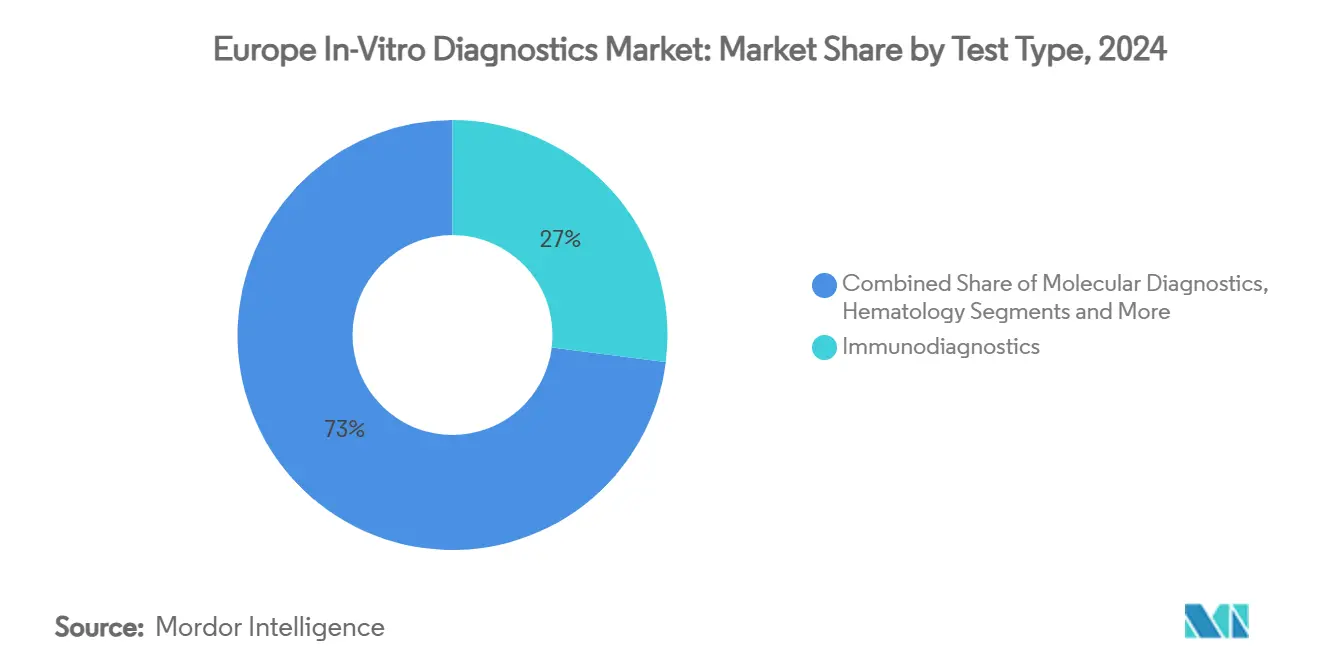
Note: Segment shares of all individual segments available upon report purchase
By Product & Service: Software Integration Drives Value Creation
Reagents and consumables delivered 65% of 2024 revenue, underlining the razor-and-blade economics that stabilise cash flow and raise switching barriers. Bulk purchasing agreements in national tenders favour incumbents, yet quality-management clauses now weigh digital-traceability functions. Instruments are trending toward open-channel architectures that flex between chemistry and immunoassay modalities, helping labs maximise analyser uptime. Middleware dashboards curate quality-control flags and utilisation analytics, nudging procurement towards holistic platform deals rather than isolated analyser sales.
The software and services segment, while smaller, is forecast to post the fastest 8.5% expansion. Labs increasingly pay subscription fees for LIS integration, AI-assisted result interpretation and regulatory documentation modules. Vendors monetise cloud-based analytics that benchmark peer performance and automate external-quality assessments. This pivot elevates digital differentiation at a time when core analytic sensitivity gains are approaching technical ceilings, sustaining competitive edge in the Europe in vitro diagnostics industry.
By Usability: Disposable Devices Expand Testing Access
Disposable devices held 58% revenue share in 2024 and are projected to clock a 6.9% CAGR. Single-use cartridges safeguard infection control in polyclinic settings and support home-testing convenience. Lateral-flow strips now cover C-reactive protein, cardiac troponin and vitamin-D assays, while microfluidic chips mount multiplex panels with minimal user steps. Environmental concerns spur suppliers to introduce biodegradable casings and take-back programs that reduce plastic waste.
Reusable devices dominate high-throughput central-lab workflows, where annual sample volumes justify capital investment. Upgrades focus on walk-away automation, self-cleaning modules and lower reagent dead-volume to curb consumable spend. Hybrid architectures pair reusable optical readers with disposable fluidics, balancing sustainability and performance across Europe in vitro diagnostics market applications.
By Specimen Type: Saliva Testing Drives Non-invasive Innovation
Blood and serum delivered 71% of 2024 specimen volume thanks to established clinical reference ranges and automated pre-analytic systems. Nevertheless, saliva sampling is rising fastest at 9.1% CAGR, propelled by pandemic-validated RT-PCR workflows that showed 98% concordance with nasopharyngeal swabs. This non-invasive medium is extending into cortisol, infectious-disease and genomic-risk panels. Urine retains importance for metabolic and drug-screening applications, while tissue biopsies underpin oncology precision, now often supplemented by circulating-tumour-DNA liquid biopsies.
Advances in proteomics and mass spectrometry heighten saliva-biomarker sensitivity, expanding disease portfolios and aligning with preventive-screening strategies. Collection kits with RNA stabilisers are mitigating pre-analytic variability, encouraging payers to incorporate salivary tests in reimbursed pathways and diversifying Europe in vitro diagnostics market offerings.
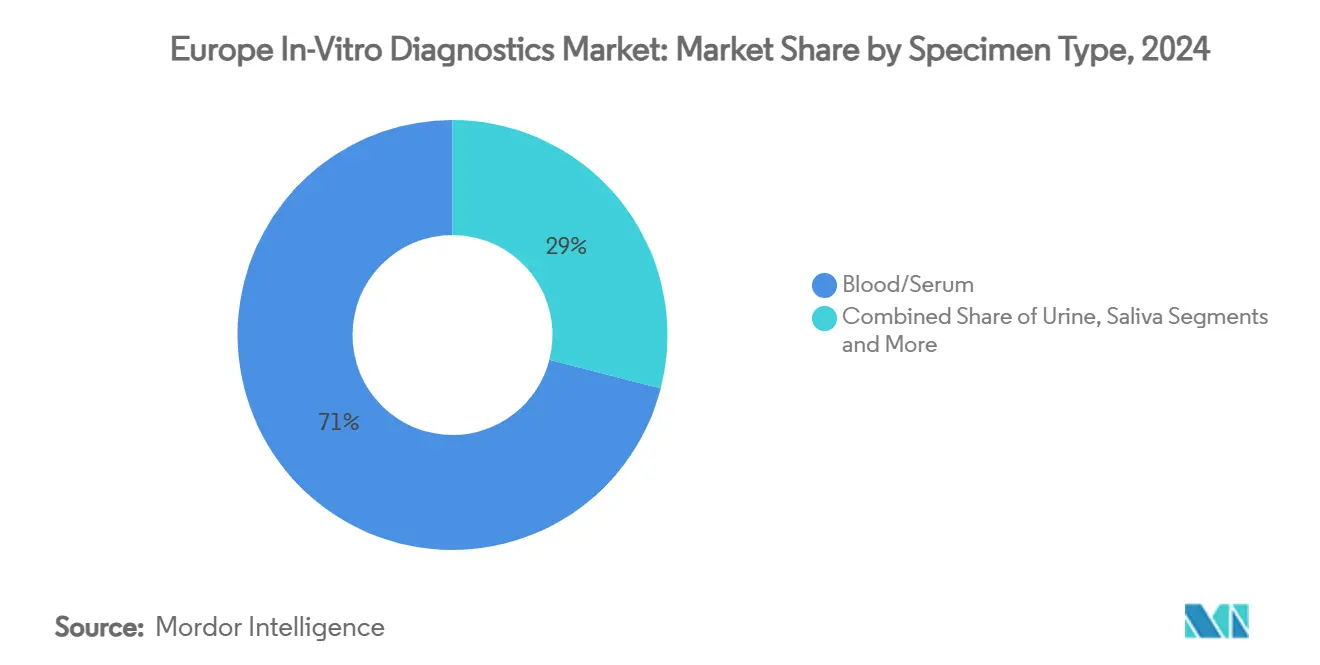
Note: Segment shares of all individual segments available upon report purchase
By Site of Testing: Decentralisation Reshapes Testing Landscape
Core laboratories still dominate test throughput, yet point-of-care hubs in GP surgeries and community pharmacies now perform high-value panels formerly restricted to hospitals. Integrated telehealth platforms allow clinicians to trigger tests remotely and receive immediate decision support. Home-testing penetration accelerated after consumers became accustomed to self-administered antigen tests. New apps pair lateral-flow cassettes with smartphone cameras to transmit encrypted images for professional validation, closing the quality-assurance gap.
Reference laboratories remain critical for exotic pathogen sequencing and ultra-specialised genomics, processing samples forwarded from smaller hospitals. Countries with single POCT oversight bodies, such as Norway, demonstrate smoother accreditation and supply logistics, offering a model for harmonisation across the Europe in vitro diagnostics market.
By Application: Oncology Diagnostics Drive Precision Medicine
Infectious-disease assays generated 33% of 2024 revenues and continue to underpin pandemic-preparedness frameworks. Respiratory and gastrointestinal panels dominate volumes, while antimicrobial-resistance markers guide stewardship. Oncology, however, is the fastest-growing use case at 6.8% CAGR, with liquid-biopsy and companion-diagnostic platforms enabling early mutation detection and therapy alignment. Expanded tumour-agnostic indications fuel demand for multi-gene NGS panels.
Diabetes monitoring remains vital amid rising prevalence, driving glucose, HbA1c and novel continuous-ketone metrics. Cardiology benefits from ultra-sensitive troponin assays that rule-in myocardial infarction within one hour. Autoimmune, renal and prenatal genetic screenings sustain double-digit test-growth pockets, leveraging multiplex arrays that consolidate comprehensive health insights. The convergence of diagnostics with cloud analytics refines risk stratification and feeds decision-support tools across Europe in vitro diagnostics market segments.
By End User: Home Testing Disrupts Traditional Channels
Hospitals and clinics owned 43% of 2024 revenue but face decentralisation as home/self-testing posts 7.5% CAGR. Consumers now routinely perform respiratory, fertility and vitamin-deficiency kits, mailing samples or transmitting smartphone images for laboratory-written reports. Reimbursement frameworks in Germany and the UK are beginning to cover telemonitored chronic-disease tests, prompting insurers to ink outcome-based contracts with device makers.
Core diagnostic laboratories modernise through track-automation and AI-enabled result validation to maintain relevance. Academic institutes spearhead biomarker discovery and validation, funnelling breakthroughs into commercial menus. Ecosystem players that integrate data across sites of care will unlock full value for the Europe in vitro diagnostics market.
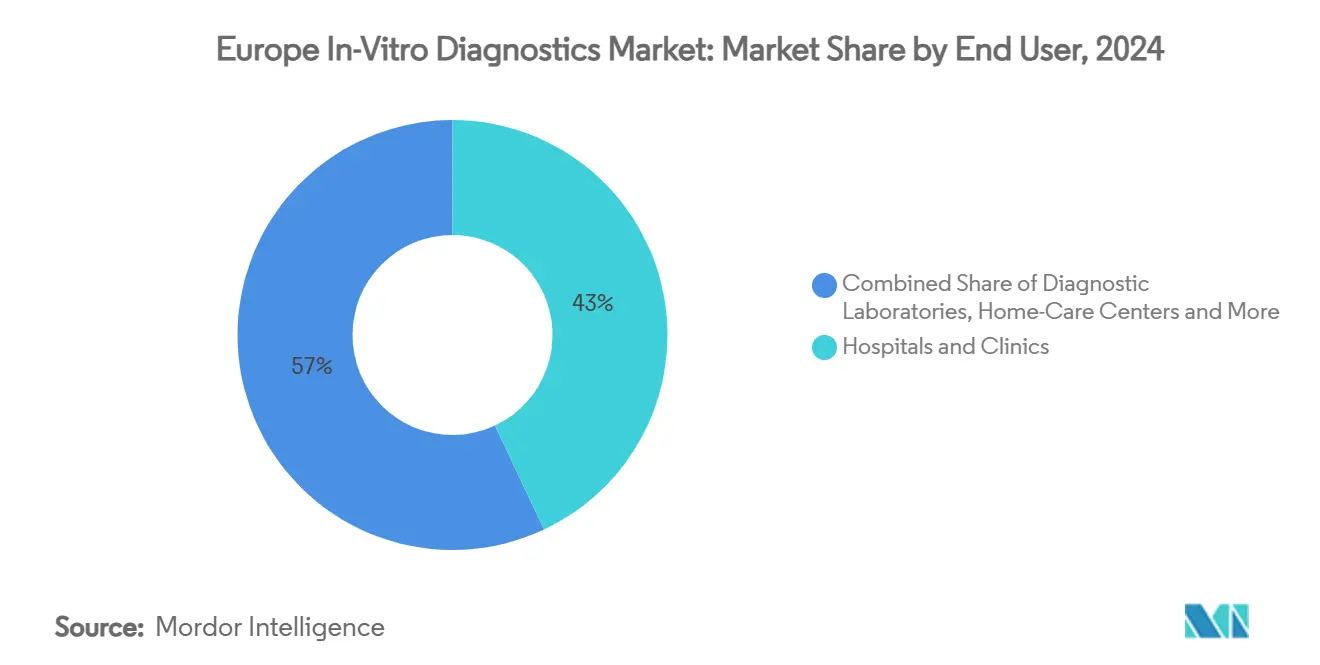
Note: Segment shares of all individual segments available upon report purchase
Geography Analysis
Germany preserved 31% regional share in 2024, propelled by robust reagent uptake, heavy R&D expenditure and early IVDR readiness. The 2025 adoption of opt-out electronic records links laboratories with national e-prescription systems, streamlining diagnostics-to-therapy loops. Ageing demographics push cholesterol, HbA1c and PSA volumes while oncology panels move deeper into community oncology clinics, cementing Germany’s anchor role within the Europe in vitro diagnostics market.
The United Kingdom records the fastest 6.5% CAGR to 2030 as NHS procurement pivots to point-of-care pathways that trim follow-up visits and broaden screening reach. Post-Brexit, the MHRA is crafting sovereign regulations that mirror IVDR rigour but promise quicker approvals, making the market attractive for innovative SMEs.
France, Italy and Spain contribute sizeable revenues yet each shows unique reimbursement hurdles for advanced molecular panels. Ongoing digital-health funding aims to harmonise care pathways, which should shorten time-to-payment for novel assays. Eastern European states observe double-digit growth off smaller bases, upgrading laboratory infrastructure with EU structural funds. Nordic systems display mature POCT governance, demonstrating that unified oversight accelerates safe decentralisation.
Competitive Landscape
Roche, Abbott, Siemens Healthineers and Danaher wield entrenched analyser-reagent ecosystems that lock in high-volume laboratories and capture the bulk of clinical-chemistry and immunoassay spend. Their balance-sheet strength eases IVDR compliance, and each is embedding cloud analytics and AI triage dashboards into instrument updates. Roche’s 2024 report highlights double-digit digital-diagnostics growth on its cobas platform. Siemens Healthineers added algorithmic cardiovascular-risk modules to Atellica, broadening utility.
Mid-tier specialists exploit white-space niches: bioMérieux’s Biofire Spotfire respiratory panel gains traction for decentralised syndromic testing. AI-native entrants such as Aiforia secured IVDR certification for digital-pathology algorithms that detect prostate- and breast-cancer features. Competition also reflects notified-body bandwidth; smaller firms align with strategic partners like Veranex to navigate certification.
Acquisition activity persists: the Danaher/Beckman integration maintained market competitiveness per European Commission assessment. Private-equity funds inject capital into regional players like Saesco, positioning them for cross-border expansion. Suppliers boasting connected-care ecosystems, cloud-based analytics and compliance-ready quality systems are expected to secure share gains within the Europe in vitro diagnostics industry.
Europe In-Vitro Diagnostics Industry Leaders
-
Illumina, Inc.
-
Sysmex Corp.
-
QIAGEN N.V.
-
bioMerieux SA
-
F. Hoffmann-La Roche AG
- *Disclaimer: Major Players sorted in no particular order
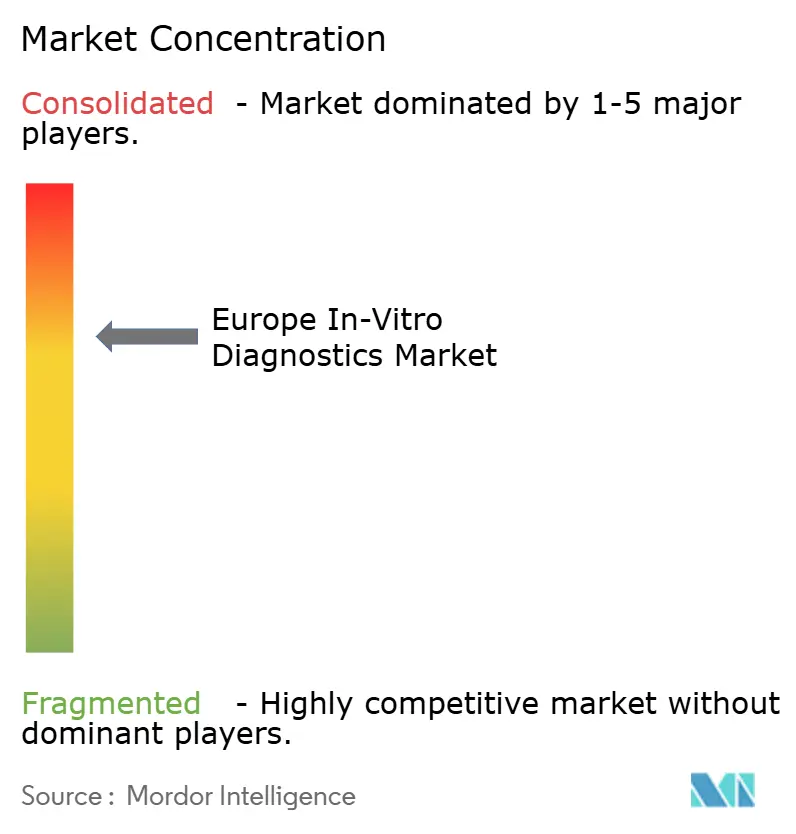
Recent Industry Developments
- May 2025: Miura Partners invested growth capital in Spanish diagnostic supplier Saesco, signalling heightened private-equity interest in regional test-kit makers.
- February 2025: Aiforia Technologies achieved IVDR certification and unveiled three CE-IVD AI models that streamline breast- and prostate-cancer pathology reads.
Europe In-Vitro Diagnostics Market Report Scope
As per the scope of this report, in-vitro diagnostics are the tests performed in laboratories or by consumers at home to diagnose, monitor, screen, and assess various diseases, conditions, or infections. IVD products are reagents, instruments, and systems intended for use in diagnosing diseases or other conditions. IVDs form an essential part of the current healthcare system. They reduce hospital stays and the need to recuperate. The Europe In-Vitro Diagnostics Market is Segmented by Test Type (Clinical Chemistry, Molecular Diagnostics, Immuno Diagnostics, Hematology, and Other Test Types), Product (Instruments, Reagents, and Other Products), Usability (Disposable IVD Devices and Reusable IVD Devices), Application (Infectious Disease, Diabetes, Cancer/Oncology, Cardiology, Autoimmune Disease, Nephrology, and Other Applications), End User (Diagnostic Laboratories, Hospitals and Clinics, and Other End Users) and Geography (Germany, United Kingdom, France, Italy, Spain, and the Rest of Europe). The report offers the value (in USD million) for the above segments.
| Clinical Chemistry |
| Molecular Diagnostics |
| Immunodiagnostics |
| Hematology |
| Microbiology & Lateral Flow |
| Other Tests |
| Reagents & Consumables |
| Instruments/Analyzers |
| Software & Services |
| Disposable IVD Devices |
| Reusable IVD Devices |
| Blood/Serum |
| Urine |
| Saliva |
| Tissue/Biopsy |
| Central Laboratories |
| Point-of-Care Testing |
| Home/Self-Testing |
| Reference Labs |
| Infectious Diseases |
| Diabetes |
| Cancer/Oncology |
| Cardiology |
| Autoimmune Disorders |
| Nephrology & Renal Panels |
| Prenatal/Genetic Screening |
| Diagnostic Laboratories |
| Hospitals & Clinics |
| Academic & Research Institutes |
| Home-Care/POC Centers |
| Germany |
| United Kingdom |
| France |
| Italy |
| Spain |
| Rest of Europe |
| By Test Type | Clinical Chemistry |
| Molecular Diagnostics | |
| Immunodiagnostics | |
| Hematology | |
| Microbiology & Lateral Flow | |
| Other Tests | |
| By Product & Service | Reagents & Consumables |
| Instruments/Analyzers | |
| Software & Services | |
| By Usability | Disposable IVD Devices |
| Reusable IVD Devices | |
| By Specimen Type | Blood/Serum |
| Urine | |
| Saliva | |
| Tissue/Biopsy | |
| By Site of Testing | Central Laboratories |
| Point-of-Care Testing | |
| Home/Self-Testing | |
| Reference Labs | |
| By Application | Infectious Diseases |
| Diabetes | |
| Cancer/Oncology | |
| Cardiology | |
| Autoimmune Disorders | |
| Nephrology & Renal Panels | |
| Prenatal/Genetic Screening | |
| By End User | Diagnostic Laboratories |
| Hospitals & Clinics | |
| Academic & Research Institutes | |
| Home-Care/POC Centers | |
| By Country | Germany |
| United Kingdom | |
| France | |
| Italy | |
| Spain | |
| Rest of Europe |
Key Questions Answered in the Report
What is the current value of the Europe in vitro diagnostics market and its expected growth by 2030?
The market is valued at USD 29.06 billion in 2025 and is projected to reach USD 37.98 billion by 2030, expanding at a 5.5% CAGR.
Which test types are growing fastest across European laboratories?
Molecular diagnostics is the fastest, forecast to grow at 7.2% CAGR as precision-medicine adoption widens.
How does the EU IVDR affect in vitro diagnostic manufacturers?
The regulation now requires notified-body review for most assays, raising compliance costs but also lifting overall quality and stimulating innovation.
Which European country is expected to record the highest diagnostic-market growth to 2030?
The United Kingdom is set to post the strongest 6.5% CAGR thanks to digital-health investment and point-of-care expansion.
Why are saliva-based tests gaining traction in Europe?
Pandemic-era validation proved saliva's diagnostic accuracy, and its non-invasive sampling drives a projected 9.1% CAGR through 2030.
What segment is challenging hospitals dominance in diagnostic spending?
Home and self-testing solutions, rising at 7.5% CAGR, are reshaping patient-testing habits and decentralising volumes away from hospital laboratories.
Page last updated on:
